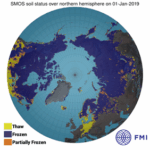Download full programme as PDF
Download the abstract book (PDF) here!
Thursday, February 17th, 2022
Morning session 10:00 – 12:05
10:00 – 10:15 Welcome and Practical arrangements, Markku Alho, University of Helsinki
10:15 – 10:45 On the possibility and relevance of small-scale dynamo action in the Sun, Maarit Käpylä, Aalto University
10:45 – 10:50 Type II radio bursts and their association with coronal mass ejections, Anshu Kumari, University of Helsinki
10:50 – 10:55 Global hybrid-Vlasov simulations of foreshock waves and their transmission into the magnetosphere, Lucile Turc, University of Helsinki
10:55 – 11:00 Magnetospheric Responses to Solar Wind Pc5 Density Fluctuations From 2D Hybrid Vlasov Simulation, Hongyang Zhou, University of Helsinki
11:00 – 11:10 Break
11:10 – 11:15 Observation-based modelling of the energetic storm particle event of 14 July 2012, Nicolas Wijsen, Centre for mathematical Plasma Astrophysics, KU Leuven
11:15 – 11:30 Virtual break-out rooms: Kumari, Turc, Zhou, Wijsen
11:30 – 11:35 Electric solar wind sail’s applicability and demonstration status, Pekka Janhunen, Finnish Meteorological Institute, Aurora Propulsion Technologies, University of Tartu
11:35 – 11:40 FORESAIL-1 cubesat mission to measure radiation belt losses and demonstrate de-orbit, Petri Niemelä, Aalto University
11:40 – 11:45 Performance and Design of COTS Components-based Magnetometer for FORESAIL-1 CubeSat, Ville Lundén, Aalto University
11:45 – 11:50 FORESAIL-2: System Engineering Challenges for Cubesat Missions in High Radiation Orbits, Marius Anger, Aalto University
11:50 – 12:05 Virtual break-out rooms: Janhunen, Niemelä, Lundén, Anger
Afternoon session 13:00 – 15:10
13:00 – 13:30 Evolution and assessment of hemispheric snow mass based on satellite data analysis, Jouni Pulliainen, Finnish Meteorological Institute
13:30 – 13:35 Supporting Paris Agreement with space-based carbon dioxide observations, Johanna Tamminen, Finnish Meteorological Institute
13:35 – 13:40 Simulations of improved glint observations over snow for CO2M, Antti Mikkonen, Finnish Meteorological Institute
13:40 – 13:45 Magnetic-local-time dependency of radiation belt electron precipitation: impact on polar ozone, Pekka Verronen, Sodankylä Geophysical Observatory, Finnish Meteorological Institute
13:45 – 14:00 Virtual break-out rooms: Tamminen, Mikkonen, Verronen
14:00 – 14:10 Break
14:10 – 14:40 Science with the James Webb Space Telescope, Seppo Mattila, University of Turku
14:40 – 14:45 The curious host galaxies of narrow-line Seyfert 1 galaxies, Irene Björklund, Metsähovi Radio Observatory, Aalto University
14:45 – 14:50 Icarus – Witnessing the erosion of a near-Sun asteroid, Mikael Granvik, Luleå University of Technology, University of Helsinki
14:50 – 14:55 Asteroid photometric phase functions from Gaia observations, Karri Muinonen, University of Helsinki, Finnish Geospatial Research Institute FGI
14:55 – 15:10 Virtual break-out rooms: Björklund, Granvik, Muinonen
Friday, February 18th, 2022
Morning session 10:00 – 12:10
10:00 – 10:30 MEDA PS & HS: First months on Mars onboard Perseverance, Maria Hieta, Finnish Meteorological Institute
10:30 – 10:35 MiniPINS – Miniature Planetary Sensor Packages for Mars and Moon, Maria Genzer, Finnish Meteorological Institute
10:35 – 10:40 Tool for optimizing the scientific operations and performance of the Mars lander, Harri Haukka, Finnish Meteorological Institute
10:40 – 11:10 From petascale to exascale: The Vlasiator semi-lagrangian grid-based plasma simulation in the age of GPU supercomputing, Markus Battarbee, University of Helsinki
11:10 – 11:20 Break
11:20 – 11:25 Properties of cavitons and spontaneous hot flow anomalies in a global hybrid-Vlasov simulation, Vertti Tarvus, University of Helsinki
11:25 – 11:40 Virtual break-out rooms: Genzer, Haukka, Tarvus
11:40 – 11:45 Over 20 year global magnetohydrodynamic simulation of Earth’s magnetosphere, Ilja Honkonen, Finnish Meteorological Institute
11:45 – 11:50 Ionospheric Precipitation of Particles in the first 6D hybrid-Vlasov Vlasiator simulation, Thijs Luttikhuis, University of Helsinki
11:50 – 11:55 The Vlasiator Ionosphere: Progress Report, Urs Ganse, University of Helsinki
11:55 – 12:10 Virtual break-out rooms: Honkonen, Luttikhuis, Ganse
Afternoon session 13:00 – 14:05
13:00 – 13:30 EISCAT future prospects for Finnish Research Community, Thomas Ulich, Oulu University, Sodankylä Geophysical Observatory
13:30 – 13:35 Large-scale high-latitude dayside aurora (HiLDA) during IMF By prevailing conditions, Lei Cai, University of Oulu, KTH Royal Institute of Technology
13:35 – 13:40 The EZIE satellite mission for measuring ionospheric electrojet currents, Heikki Vanhamäki, University of Oulu
13:40 – 13:45 Spatio-temporal development of large scale auroral electrojet currents relative to substorm onsets, Sebastian Käki, Finnish Meteorological Institute, University of Helsinki
13:45 – 13:50 Space weather advisories for civil aviation: Experiences gathered by the PECASUS service, Kirsti Kauristie, Finnish Meteorological Institute
13:50 – 14:05 Virtual break out rooms: Cai, Vanhamäki, Käki, Kauristie



